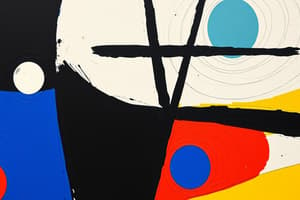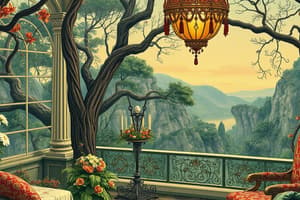Podcast
Questions and Answers
What refers to artistic works produced during the late 19th century to mid-20th century?
What refers to artistic works produced during the late 19th century to mid-20th century?
Modern Art
Who is often considered the father of Modern Art?
Who is often considered the father of Modern Art?
Paul Cézanne
What movement was co-founded by Pablo Picasso and Georges Braque?
What movement was co-founded by Pablo Picasso and Georges Braque?
Cubism
What did Surrealism seek to release?
What did Surrealism seek to release?
What was Marcel Duchamp's contribution to Dadaism?
What was Marcel Duchamp's contribution to Dadaism?
Which movement emphasized loose brushwork and light?
Which movement emphasized loose brushwork and light?
What did Futurism celebrate?
What did Futurism celebrate?
What is Minimalism known for?
What is Minimalism known for?
Who was a leading figure in Abstract Expressionism?
Who was a leading figure in Abstract Expressionism?
What did Pop Art draw inspiration from?
What did Pop Art draw inspiration from?
What was the goal of the Bauhaus school?
What was the goal of the Bauhaus school?
Which artist is known for 'The Starry Night'?
Which artist is known for 'The Starry Night'?
What movement does Edvard Munch's 'The Scream' belong to?
What movement does Edvard Munch's 'The Scream' belong to?
Who was known for grid-based compositions in De Stijl?
Who was known for grid-based compositions in De Stijl?
What is Suprematism focused on?
What is Suprematism focused on?
Flashcards are hidden until you start studying
Study Notes
Introduction to Modern Art
- Modern Art emerged from the late 19th to mid-20th century, departing from traditional artistic styles.
- It encompasses various movements that challenged conventional forms and explored innovative representations of reality.
Paul Cézanne and the Birth of Modern Art
- Paul Cézanne (1839-1906) is often regarded as the father of Modern Art.
- His work connected 19th-century Impressionism with the emerging Cubism movement, influencing future artists through his innovative use of form and color.
Cubism and Pablo Picasso
- Cubism, co-founded by Pablo Picasso (1881-1973) and Georges Braque, revolutionized perspective in art.
- It focused on fragmented forms and multiple viewpoints, exemplified by Picasso's groundbreaking painting "Les Demoiselles d'Avignon" (1907).
Surrealism and the Unconscious Mind
- Founded by André Breton in the 1920s, Surrealism aimed to unlock creativity through the unconscious mind.
- Notable artists like Salvador Dalí (1904-1989) and Max Ernst created dreamlike imagery, with Dalí's "The Persistence of Memory" (1931) being a defining work.
Marcel Duchamp and Dadaism
- Dadaism arose as a reaction to World War I, emphasizing absurdity and irrationality in art.
- Marcel Duchamp (1887-1968) challenged art's definitions with "readymades," such as his infamous "Fountain" (1917), a signed urinal that questioned artistic value.
Impressionism and Claude Monet
- Impressionism emerged in the late 19th century, marked by loose brushwork and a focus on light.
- Claude Monet (1840-1926) was central to this movement, with "Impression, Sunrise" (1872) giving the movement its name and capturing fleeting moments.
Futurism: The Art of Modernity
- Founded in Italy in the early 20th century, Futurism celebrated the speed and dynamism of technology.
- Artists like Umberto Boccioni and Giacomo Balla depicted motion and energy, reflecting societal changes during the industrial age.
Minimalism: Less is More
- Minimalism arose in the 1960s as a reaction against the emotional complexity of Abstract Expressionism.
- It focused on simplicity and geometric forms, with artists like Donald Judd and Frank Stella emphasizing the inherent materiality of their work.
Abstract Expressionism and Jackson Pollock
- Abstract Expressionism developed in the U.S. during the 1940s and 1950s, with Jackson Pollock (1912-1956) as a leading figure.
- His "drip paintings" exemplified spontaneous, subconscious creation, marked by poured and splattered paint on large canvases.
Pop Art and Andy Warhol
- Pop Art emerged in the 1950s and 1960s, inspired by popular culture and mass media.
- Andy Warhol (1928-1987) became a key figure, using techniques like silkscreen printing to create iconic works featuring everyday objects, such as "Campbell's Soup Cans" (1962).
Bauhaus and the Fusion of Art and Design
- The Bauhaus school, founded in Germany in 1919, aimed to unify art, craft, and technology.
- It significantly influenced architecture and design, encouraging practical applications of art in daily life.
The Legacy of Vincent van Gogh
- Vincent van Gogh (1853-1890), largely unrecognized during his lifetime, left a profound impact on Modern Art.
- His expressive use of color and brushwork, evident in works like "The Starry Night" (1889), portrayed emotional intensity and the narrative of the tortured artist.
Expressionism and Edvard Munch
- Expressionism emerged in the early 20th century, focusing on raw emotional content.
- Edvard Munch's (1863-1944) "The Scream" (1893) is a seminal piece, illustrating existential angst and despair.
De Stijl and Mondrian
- De Stijl (“The Style”) emphasized abstraction and simplicity with straight lines and primary colors.
- Piet Mondrian (1872-1944) was a major proponent, known for grid-based compositions that aimed to convey universal harmony.
Suprematism and Kasimir Malevich
- Suprematism was founded by Russian artist Kasimir Malevich (1879-1935), focusing on basic geometric forms.
- It sought to express pure artistic feeling rather than representational accuracy.
Studying That Suits You
Use AI to generate personalized quizzes and flashcards to suit your learning preferences.




